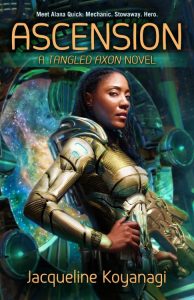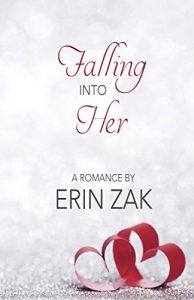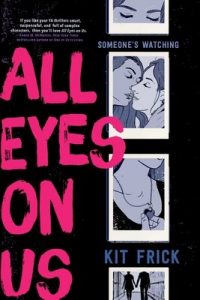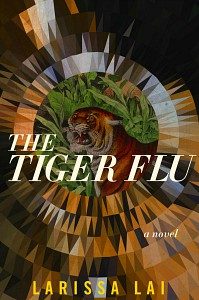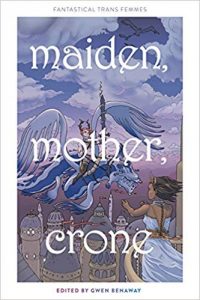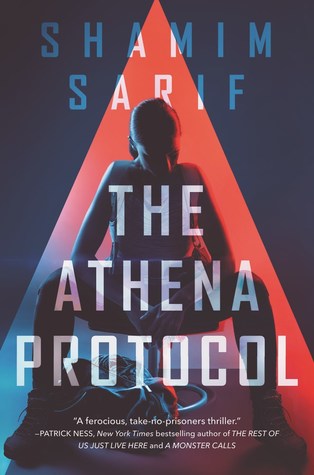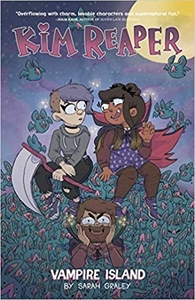Reading Jacqueline Koyanagi’s Ascension has been long overdue for me. This sapphic Sci-Fi with a metaphysical twist is the type of read you don’t often find in the genre.
It centers on Alana, an engineer specializing in spaceship repair. She has a special connection with energy and metal, an inexplicable bond that drives her devotion.
She and her aunt Lai survive only on the pittance given to them by the sparse work arriving at their engineering station.
In their rapidly decaying planet, survival is a daily struggle that most times comes short. It is this fact, propelled by Alana’s hidden desires, that prompts her to stowaway on a ship whose crew arrives at her station looking for her sister, Nova, who is something akin to a spiritual life coach.
Told from Alana’s first-person POV, the outset of this story swiftly establishes an interesting background. Jacqueline wastes no time in capturing your attention with her setting, one that highlights the destructive consequences gentrification and a corporate-monolithic society have on minority communities.
I was immediately drawn to this discussion on lack of opportunity and accessibility (the major in the book being accessibility to healthcare, due to Alana and her aunt’s chronic illness), drawing clear parallels to our contemporary world and dissecting it, exposing its entrails for all readers to see.
In Ascension, the oppressive force is Transliminal, a corporation from another universe that has seized control of technological and medicinal advancements.
Through Alana’s chronic condition we are given a lens into the many failings of our society when it comes to the intersectionality of marginalized identities and illness.
Alana’s chronic pain does not define her, yet it is an inherent part of her. Her disorder also helps carve a clear picture of this society’s inequality, and the decisions people with a chronic illness have to face to live another day.
Alana does have some agency over her pain, frequently demonstrating a tremendous force of will and powering through it in critical situations (which eventually leads to her ceding ground to it). She expresses in equal measure the insecurities, exhaustion, and relentlessness that come with an arresting illness.
It sparked a fire in me to read a character like that, with a side that doesn’t usually make it on the cast roster, much less the main stage.
Family is the catalyst for this very much character-driven story, but I could not fully connect to their relationships.
They have a good dynamic, but trust seems to come conveniently easily between them, sometimes going against their own words. Backstories are delivered very matter-of-factly, at moments defined to make you immediately care for them.
I personally need a bit more first-hand emotional involvement but there were still exciting things about the cast I deeply enjoyed. They are a diverse cast, including disabled characters and lgbtq+ characters, who are people with real worries and connections.
Asides from the sapphic romance, there’s also a polyamorous relationship (I loved how healthy it was!), and there’s an effort to make them more than a cardboard cut-out of their identities meant to check a box.
It’s clear they come from a place of respect and this is exactly the sort of representation that elevates a story for me.
Though the beginning crafts this gripping message wrapped around a new world, many times it’s not picked apart enough. I felt I was not eased into many of the workings and concepts of this world, nor allowed to explore them. I could not prod at the worldbuilding like I love to do, instead, I had to surmise it by myself.
It was the ending that inevitably pulled me in and GOD. WHAT AN ENDING. The excitement and mystery in these final chapters fully enraptured me, delivering a plot twist that I was definitely not expecting.
All in all, there is much to like about this book and even with its slightly underdeveloped underpinnings, I found this a satisfying story that reaches further into the possibilities of the genre.
Arina first discovered stories through their grandparents, who would regale them with tales of misbehaving kangaroos and gentle untailed monkeys, igniting a spark that would spread the wildfire of their love for books. Currently, they mostly brave the wild worlds of SFF but is actually a sucker for any great journey no matter its realm. You can find them at @voyagerarina and their blog.

